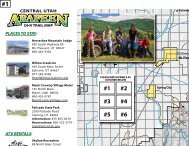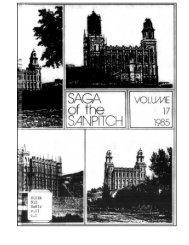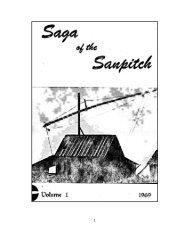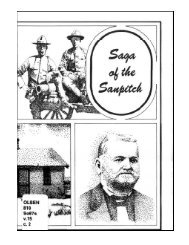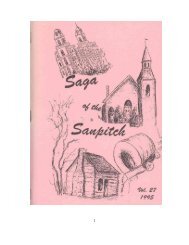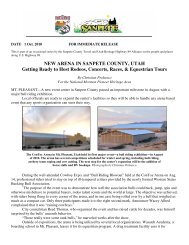Saga of the Sanpitch Volume 13, 1981 - Sanpete County
Saga of the Sanpitch Volume 13, 1981 - Sanpete County
Saga of the Sanpitch Volume 13, 1981 - Sanpete County
- TAGS
- saga
- sanpitch
- volume
- sanpete
- sanpete.com
Create successful ePaper yourself
Turn your PDF publications into a flip-book with our unique Google optimized e-Paper software.
First <strong>the</strong> meat must be saturated with strong salt brine. The brine was made by heating a tub <strong>of</strong> water<br />
over an outside sagebrush fire. Several pounds <strong>of</strong> rock salt were added as <strong>the</strong> solution boiled vigorously.<br />
When a potato would float on <strong>the</strong> salty brine, <strong>the</strong> solution was ready. The wooden barrel (so important in our<br />
life) was thoroughly cleaned and brought to <strong>the</strong> cellar. The six pieces <strong>of</strong> meat were packed into it. We used<br />
buckets to transfer <strong>the</strong> brine from <strong>the</strong> tub to <strong>the</strong> barrel. The meat was completely covered and must remain<br />
so for days until each piece was thoroughly saturated.<br />
Now to make <strong>the</strong> sausage. The meat scraps from <strong>the</strong> trimming process were put through a meat<br />
grinder. Mo<strong>the</strong>r let me turn <strong>the</strong> grinder while she inserted <strong>the</strong> meat, always careful that her fingers did not<br />
mingle with <strong>the</strong> scraps. The ground product was mixed with salt, pepper and sage, ready now for <strong>the</strong> stuffing<br />
process. The end <strong>of</strong> a cleaned intestinal casing about an inch in diameter was stretched over a little hornlike<br />
fixture. The meat was pressed through <strong>the</strong> horn into <strong>the</strong> casing. As it began to fill, <strong>the</strong> meat was pressed<br />
still more firmly into it. Yards <strong>of</strong> one-inch diameter tubes appeared. About every twelve inches, <strong>the</strong> long tube<br />
was twisted in such a way that links were formed.<br />
While <strong>the</strong> sausage was being made, <strong>the</strong> pig's head had been boiling in our large copper boiler on top <strong>of</strong><br />
<strong>the</strong> kitchen stove. When it was thoroughly cooked, <strong>the</strong> head was removed. The meat was separated from <strong>the</strong><br />
bone and put through <strong>the</strong> meat grinder. It was mixed with salt and pepper and placed in round twelve-inch<br />
pans. A dinner plate was pressed on top <strong>of</strong> each pan and a heavy flat iron put on top to press <strong>the</strong> meat into<br />
"headcheese."<br />
The pleasant task <strong>of</strong> sharing some <strong>of</strong> our "goodies" with relatives and friends began. In each <strong>of</strong> several<br />
gift packages, we enclosed some sausage links, a piece <strong>of</strong> liver, some headcheese and a portion <strong>of</strong> fresh spare<br />
ribs.<br />
I don't know how my parents knew when it was time to remove <strong>the</strong> pork from <strong>the</strong> brine barrel. It was<br />
lifted from <strong>the</strong> brine, loaded in <strong>the</strong> wagon and transported to grandma's "smokehouse." Grandma did what<br />
she called "custom smoking" <strong>of</strong> meat for <strong>the</strong> community, earning extra money for this service. The<br />
smokehouse was a tower like structure about twelve feet high and six feet square. It was built on a rock<br />
foundation and was constructed to hold fire to produce smoke. The meat was hung carefully on hooks inside<br />
<strong>the</strong> smokehouse and <strong>the</strong> top was closed. A fire made <strong>of</strong> dry apple tree limbs was used to produce smoke that<br />
saturated <strong>the</strong> meat.<br />
While <strong>the</strong> smoking process was going on, we returned home to "render <strong>the</strong> lard." The copper kettle<br />
was filled with fat scraps that had been trimmed earlier from <strong>the</strong> larger sections <strong>of</strong> pork. The contents were<br />
cooked until <strong>the</strong>y were rendered. The crystal clear grease was <strong>the</strong>n poured into half-gallon cans, and when<br />
cooled, it became snow white lard. This was used in recipes calling for shortening. Sometimes we used it on<br />
bread instead <strong>of</strong> butter. When it was fresh and properly salted, it really was quite a tasty spread. Townspeople<br />
<strong>of</strong>ten came to our house to buy cans <strong>of</strong> this lard for <strong>the</strong>ir use.<br />
When <strong>the</strong> smoking process was complete, we removed <strong>the</strong> pork from <strong>the</strong> smokehouse. It was light<br />
brown and had a tangy inviting odor.<br />
We were conservative in our use <strong>of</strong> pork. It was not healthy to eat too much. The fatter portions <strong>of</strong> <strong>the</strong><br />
side meat (bacon) were used first, as were <strong>the</strong> fat sections <strong>of</strong> <strong>the</strong> large pieces called "shoulder." When <strong>the</strong>se<br />
were gone and winter came, we began to use <strong>the</strong> choice lean meat from <strong>the</strong> hams. I guess this is what was<br />
meant by eating "high on <strong>the</strong> hog."<br />
Our family found that this "porker" and a second one, produced adequate meat for <strong>the</strong> entire year. It<br />
lasted through <strong>the</strong> next summer and into fall. During <strong>the</strong> summer, we would be fattening o<strong>the</strong>r pigs for <strong>the</strong><br />
next year. We were now more keenly aware <strong>of</strong> what it meant to go from "porker to pork."<br />
Source: Personal recollection <strong>of</strong> <strong>the</strong> author.<br />
43



